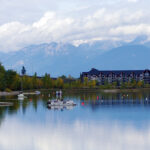Home »

Sandhill Cranes – our true-life big bird
By Dan Hicks
In August’s dry Douglas fir-ponderosa pine open grassy forest north of Cranbrook, a wary greater sandhill crane (Antigone canadensis tabida) keeps a sharp eye out for predators as it grubs around for tasty sustenance – berries, insects, reptiles, and snails (pictured above).
Sandhill cranes are graceful updraft-riding soaring birds; a regal winged presence in our British Columbia skies, the greater subspecies may grow to 1.4 metres in height with a wingspan of 2.3 metres.
The cranes derive their name from sand hill terrain such as Nebraska’s Sandhills, vast grass- stabilized wetlands that are an integral part of the avian migrational Central Flyway over the Great Plains. Of the five definite sandhill crane subspecies (a sixth is dubious), the greaters and lessers (Antigone canadensis canadensis) are the migrators but, although the southwestern US states and Texas are overwintering areas they have in common – and they do mix, the greaters fly no further north to breed than southern western Canada, but the lessers, whose wintering grounds include northern Mexico, fly all the way north to breeding grounds in Boreal and Arctic Canada, and the Alaskan and Siberian Arctic; defying their “lesser” label – they try harder – flying much farther than the greaters and outnumbering them by a factor of four (lessers = 400,000).
The three non-migratory subspecies dwell exclusively within limited home territories in Mississippi, Georgia and Florida, and Cuba. As ancient as they appear, the sandhills have a North American fossil lineage dating back ten million years; like us, they got their start in those happy halcyon days of the Miocene epoch.
In April or May, the females lay up to three eggs which incubate for a month in a ground nest hidden within the cranes’ favoured habitat – open grasslands, meadows, and shallow freshwater marshes. Rather than being helplessly altricial, the hatchlings are precocial – they are highly developed – with open eyes, downy feathers and a deep yearning to take to the sky – they can leave the nest in a day, but bi-parental brooding from their proud monogamous parents usually continues for three weeks.
In the southern Rocky Mountain Trench, from Invermere to Cranbrook, the number of known nesting greater sandhill crane pairs this spring was upwards of 10; the frantic distractive behaviour of panicking parent birds will announce the presence of a nest to intruding humans. Unfortunately for sandhill cranes, whose natural lifespans extend up to 35 years, their ground-dwelling nature makes them prime meal candidates for a host of stealthy ground varmints and hungry eagles from above; meanwhile, their eggs and chicks are vulnerable to being consumed as country hors d’oeuvres by a collection of winged predators – corvids, hawks, falcons, and owls.

With mid-September’s advent, our East Kootenay greater sandhill cranes escaped our impending winter by flying south to their age-old wintering grounds such as Bosque del Apache National Wildlife Refuge in New Mexico; massing en route, and once there, congregating in flocks of up to 10,000.
In British Columbia’s Chilcotin region, greater sandhill cranes were sufficiently abundant to induce gregarious group migration commencement behaviour and, on September afternoons, I have observed them circling continuously in a great altitudinous sky column, uttering their distinctive primeval croaking calls as they made plans to fly to a sequestered nocturnal roost of their collective choosing; sometimes dissolving their column into lineal formations upon achieving an aerial consensus. Such distinctive avian aerial flock choreography is a sight to be cherished as it faintly echoes the lost world of migrating passenger pigeons who passed overhead in numbers which eclipsed the sun throughout the day, yet whose masses could nonetheless also astound with their concordant maneuvering.
By arriving earlier in the great northward spring migration’s Nebraska stopover, snow geese and Canada geese outcompete sandhill cranes for diminishing amounts of critical waste corn. Regardless, we humans can rightfully claim to be the crane’s most threatening competitor.
My Cranbrook crane’s grassy pastoral summer haunt might well also attract an upscale suburban subdivision, or perhaps an awesome solar panel array; either way – whether big footprint housing or pseudo-green energy enterprise – big bird would forever lose some East Kootenay terrain that once served as its timeless seasonal habitat home.
Sources: Wikipedia.org, Birdsna.org, Allaboutbirds.org, & ornithologically attuned Rocky Mountain Naturalists.
Greater sandhill cranes in flight high over Alexis Creek (telephoto image), Chilcotin region, BC. September 18th, 2012.
Photos by Dan Hicks








